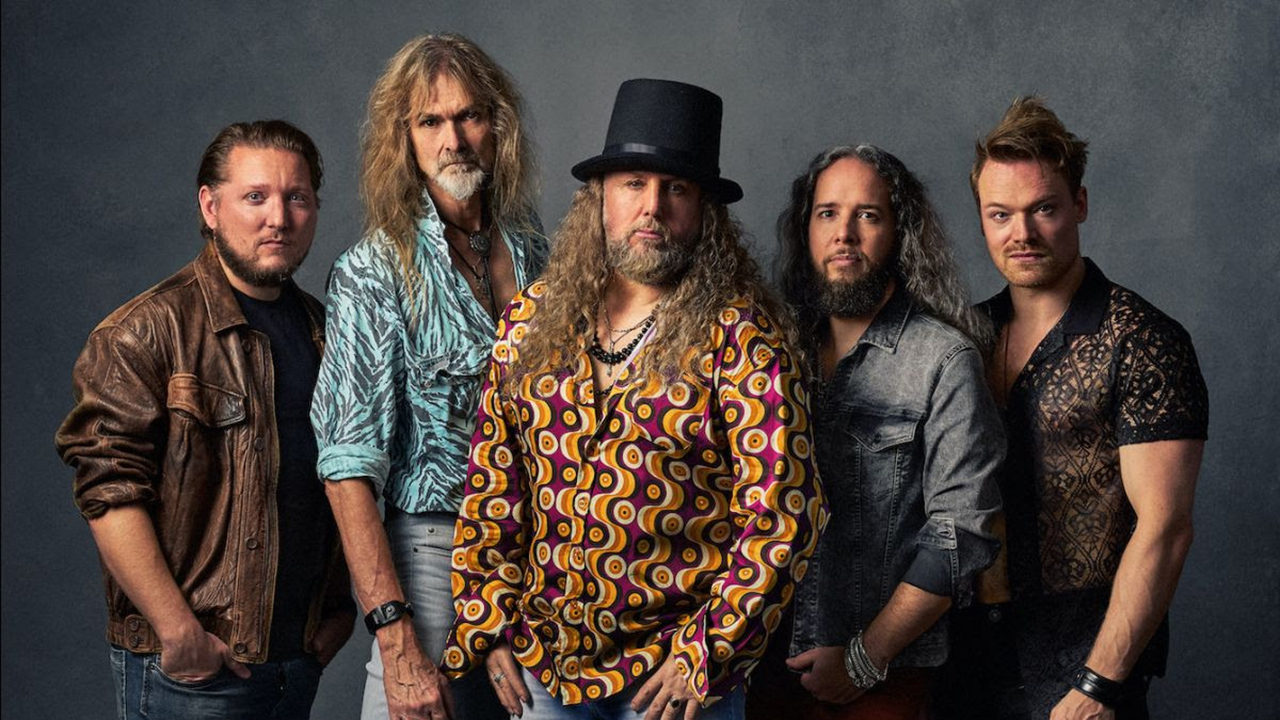“I suppose it will turn some people off. It’s not a typical prog album. It’s not Yes or Genesis. But it’s not a metal album either. The concept is the 70s!” Arjen Lucassen chooses his words carefully. But, as always, the towering Dutch prog rocker is spot on. We’re discussing The Golden Age Of Music, the debut album from Arjen Lucassen’s Supersonic Revolution, a new quintet Lucassen has put together to celebrate an era of music that has left an indelible mark on the musician: the 70s.
However this time there’s a difference. Unlike the long list of projects that Lucassen has delighted prog fans with over the years – Ayreon, Guilt Machine, Star One, The Gentle Storm, Stream Of Passion, Ambeon – Supersonic Revolution feels different. True, as Lucassen states, it’s not wholly a prog record. But then neither is it a metal album. Yet there’s enough within the record’s 11 tracks (not to mention a bonus disc featuring covers of 70s songs by T. Rex, ZZ Top, Roger Glover and Earth, Wind & Fire) to satisfy fans of both. Put simply, if you enjoyed Pink Beatles In A Purple Zeppelin, the second track from Lucassen’s 2012 solo album Lost In The New Real, then you’ll probably enjoy Supersonic Revolution’s The Golden Age Of Music too.
“For me the 70s were the golden age of music,” Lucassen enthuses. “But that’s purely personal! If I’d been born 10 years later, I guess it could have been the 80s. I used to lie in bed under the blankets and secretly listen to pirate radio stations like Radio Caroline on a little transistor radio. Those pirate stations played all kinds of weird underground music and I loved it! I also loved 70s fashion, with the colourful shirts and bell bottom jeans.”
But it’s not just the music, a delightful, big-sounding romp through the joys of most of what was great about the sounds of the 70s. Lucassen has also foregone his usual practice of engaging singers and musicians from the prog and rock worlds to create his musical visions, and instead formed a bona fide band: long-time keyboard player Joost van den Broek, guitarist Timo Somers, drummer Koen Herfst and Praying Mantis singer John ‘Jaycee’ Cuijpers.
“For drums, of course, I always work with Ed [Warby], but this time I had to have the music within the week and Ed doesn’t have his own studio, so I asked Joost if he knew anyone,” he explains. “He said there’s this guy, Koen Herfst, the drummer of Vandenberg right now. And he’s got his own studio. So I sent some stuff to him, I got it back the next day and it was brilliant. And such a nice guy, too. It was an obvious choice. Timo I’ve known since he was a baby because I played with his dad, Jan Somers, in Vengeance back in the 80s. Jan was the best guitar player in Holland and his son is an even better player! So he was an obvious choice.
“And Jaycee, I worked with him about 20 years ago. After that, unfortunately, I kind of forgot about him. We did the Ayreon shows and Russell Allen couldn’t do it at the last moment and I thought, ‘Let’s try Jaycee.’ He came to the rehearsal and I had him do Dawn Of A Million Souls [from Ayreon’s 2000 album Universal Migrator Part 2: Flight Of The Migrator] and he totally nailed it. He’s about my age, maybe five years younger than me, so he grew up with the same stuff I did. And we are both the biggest Dio fans in the world. I guess it shows.”
While there are plenty of references for Deep Purple and Rainbow fans to pick up on throughout The Golden Age Of Music, the inspiration for the new project came not from such keyboard- led heavy rock, but from some low- slung, gritty southern blues and hard rock. ZZ Top’s 1975 rocker Heard It On The X, to be precise.
“Eclipsed magazine in Germany contacted me,” Lucassen explains. “They asked if I had any cover versions lying around. I said, ‘No, but I’ll happily record one for you.’ So they gave me a list of bands and I saw a ZZ Top song I really liked and said, ‘Well, I can record it for you.’ They then said it had to be ready in a week and I was like, ‘Oh my God!’ So I contacted these musicians in Holland on WhatsApp and literally in 30 minutes I assembled five people. I sent a demo to each and every one of them. And within a few days I got all the files back from them.
“I’m a perfectionist, as you know, so I’m always sending people stuff back saying it’s not good, change this, etc... It was all brilliant. We were calling and WhatsApping and within a week we had a complete product. It was so much fun because working on Ayreon or Star One... To get all those musicians, like the last Star One, it had, like, 20 guest musicians and it’s hell arranging all that. I just wanted to have fun again.”
Fun seems to be the key here. It’s a word that trips off the Dutch musician’s tongue time and time again during our conversation. In fact, this writer hasn’t seen Lucassen so positively upbeat and rocking about a project for some time.
“I wanted to have a fun project,” he beams. “Ayreon was pretty dark; the last Star One was pretty dark. If you see interviews with me, I am always laughing and having fun. I wanted a band that reflects that. I want five guys to have fun. And since I did ZZ Top I was like, ‘Let’s do a project, let’s form a band and let’s write songs in the style of the 70s because that’s our formative years.’
“The whole glam rock thing – that’s what started it for me. But I didn’t want it to sound like the 70s you know because that’s already been done, and I can’t do it any better than Stargazer or Kashmir. Which is good because the guys are all young. They’re around 30, so they weren’t alive in the 70s. So it was a great way for me to make 70s music with Hammond organ but to update it to this time, basically.”
As Lucassen himself says, he can be viewed as a control freak. Yet giving his fellow Supersonic Revolution bandmates the space and time to bring their own character to the band’s music makes the whole project buzz with a vibrant energy. “I’m so glad to hear you say that because that was the idea from the beginning,” he nods. “And again, it’s giving them as much freedom as can be and they took it. I can only do that when I look up to musicians. I have to look up to them and think they’re better than me and they can teach me. I’ve got a lot of experience but they can teach me so much. I have to look up to them and respect their opinion.
“It was very important that I give them space. I wouldn’t tell the guitar player, ‘I want it to sound like this,’ or ‘I want this.’ Instead I played the part for the guitar player and said, ‘This is the basic, please make it your own. Your solos, do whatever you want.’ Sometimes I do complain. Sometimes it’s like ‘Play this note,’ and they’re like, ‘Thank you, this sounds better.’ That’s the situation you want, basically.
“It’s the same word that comes up all the time and that’s ‘fun’. It was just fun. And each time I got something in from them, I loved it and it was better than I could have imagined myself. It was so easy. I can’t do that in the big projects.”

